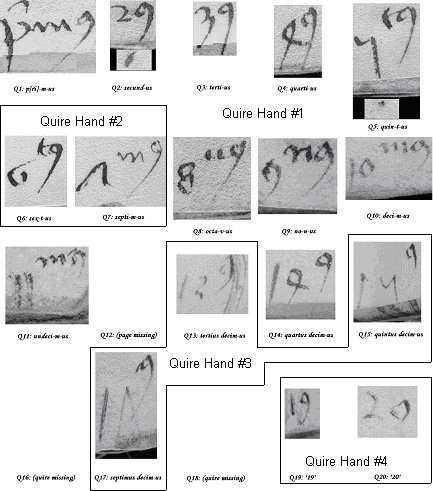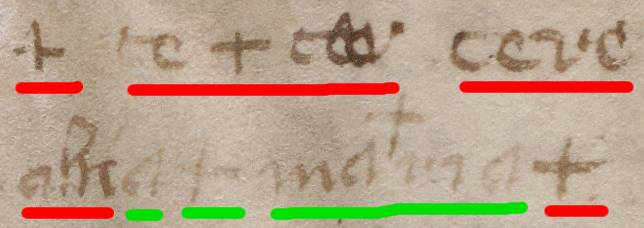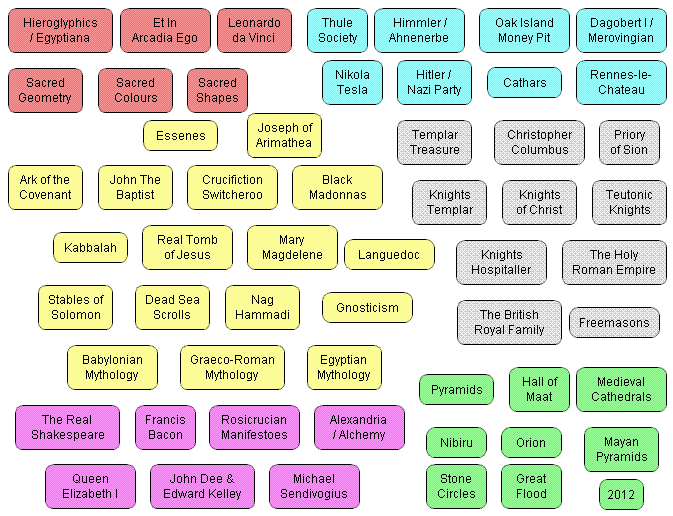In 1931, John Matthews Manly (who was very sharp, both historically and cryptologically) pointed out that the Voynich quire numbers were written in a 15th century hand – you can tell this from the characteristic ‘4’s, ‘5’s, and ‘7’s. To be precise, even though a fair few of the VMs quire numbers appear to have been added later (most obviously the numbers for Q19 and Q20, but also those for Q6 and Q7) for reasons as yet unknown, the bulk of them are indeed 15th century.

The four quire hands, from The Curse of the Voynich (2006) p.17
What isn’t widely known is that there is also a (quite different) 15th century hand in the marginalia. Even though some people like to dismiss the hard-to-understand writing on the back page of the VMs (f116v) as merely “pen trials” or “doodling”, I think you can look past the codicologically tangled mess to see that the earliest (faint) hand has distinctively 15th century letter-shapes, as underlined in green here:-

Whatever all the other words on f116v happen to read (and people will no doubt continue to debate that for a fair while yet), I’m pretty sure that this faint (but apparently unemended) section reads “a + ma+ria“, and that it is (from the distinctive shape of the three ‘a’ characters) written in a 15th century hand, one quite different from the quire numbers.
What does this tell us? Given that the Voynich Manuscript almost certainly turned up in Rudolf II’s Imperial Court in the first decade of the 17th century, and assiduous archival trawling has turned up no definite earlier reference to it, I believe that this points to two main scenarios to choose from:-
- [Real] It’s a genuine mid-15th century object.
- [Hoax] It’s a (probably late-)16th century fake, designed to resemble a genuine mid-15th century object.
To which I would further add that Voynichese is apparently designed to look like an enciphered 14th century herbal (i.e. written in a medieval simple substitution cipher, with medieval herbal illustrations, and medieval page references), even though the parallel hatching and handwriting are both 15th century in style. All of which suggests three scenarios to consider:
- [Real] It’s a genuine mid-15th century object designed to resemble an enciphered 14th century herbal.
- [Clever Hoax] It’s a (probably late-)16th century fake, designed to resemble a genuine 15th century object designed to resemble an enciphered 14th century herbal.
- [Dumb Hoax] It’s a (probably late-)16th century fake, designed to resemble an enciphered 14th century herbal, but with a number of 15th century details included by mistake.
All the same, is it really the case that one individual late-16th century hoaxer / faker was sophisticated enough to add multiple 15th century hands to the quire numbers and back page? Well… possibly: but it should be no surprise that I think the historical odds are very much against it. Your mileage may vary, of course.
(As an aside, it has recently been suggested that the VMs might have come from around 1300 (and I shall soon be posting about Patrick Lockerby’s series of VMs-related posts): but the presence of parallel hatching in the VMs would seem to be a strong indication that even 1400 would be too early a date.)


